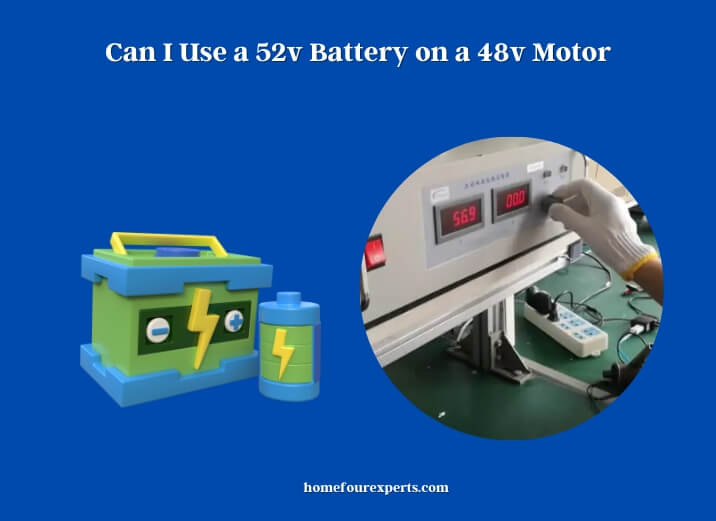Published on: May 12, 2022
Written by Liam Jaxon / Fact-checked by David Rowan
The advantages of using a 52V battery are increasing speed and torque, and nowadays, it’s become popular among riders. But newbies are confused and ask the simple question-“can I use a 52v battery on a 48v motor?“.
Yes, it’s doable. The majority of the time, a 52V battery works quite well with a 48V controller; the only issue is that the battery level indicator on the LCD is wrong. The controller must be able to handle 52V; few of them can, some cannot. It may occasionally strike by overvoltage, but it would not be damaged overall.

The biggest advantage of 52 volts is that it allows you to retain and reach higher speeds when you get speeds above 25 mph without losing power. The majority of motors are capable of operating at 52V without issue. However, the voltage of the motor is restricted by the insulation in the winding.
Their overall power output (watts) will be limited over time, which will result in heat buildup as a result of this. If you’re considerably overdriving a motor, it’s a good idea to keep an eye on the motor’s temperature in terms of rated wattage. Here we discuss whether it is wise to use a 52V battery on a 48V motor and so on.
Relation Between Controller and Battery
Controllers are equipped with circuitry that detects the voltage. Not only is this information needed to adjust motor speed, but it is also used to protect your battery. Lithium batteries should never be operated at a voltage lower than 3.0V/cell.
On the other hand, the controller cannot sense individual cell voltage; therefore, it must rely on aggregate pack voltage to determine cell voltage. Due to the fact that 48V batteries have 13 cells and 52V batteries have 14 cells, the cell voltage calculations are incorrect.
Fortunately, the majority of controllers will continue to function. You’ll need to double-check that the low and high-voltage cutoffs are compatible with your batteries. Typically, this information is printed on a label that is affixed to the controller.
If you don’t have it, you can order it from the manufacturer. Most of the controllers are capable of handling 52V. The hard limit is determined by the power contained within the controllers, which are typically designed to switch a maximum of 60 volts. A fully charged 52V battery has a voltage of 58.8V, which means it is still safe.
Benefits of Using a 52v Battery
Increasing the battery power to 52V will offer you a 10% increase in power, which turns to somewhat faster acceleration and a slightly higher top speed (if your controller has no speed limiter). There are various benefits to using a 52v battery, which is listed below:
- The 52V battery is more efficient and performs better;
- A 52V battery uses fewer amps to produce the same or higher power;
- It powers the motor faster than a 48V;
- It runs at a lower current (amp) that reduces heat buildup and early failure;
- It has a greater range than a 48V battery;
- On the charger, a 52V battery will produce nearly 59V, whereas a 48V battery will produce around 54.5V.
How to Charge a 52v Battery?
You can use any voltage you want on any motor; you only need to limit the amps. Voltage destroys controllers, whereas amps destroy motors. Now you may be thinking, “What should a 52V battery charge to?” In order to charge a 52V battery, you need to utilize a 52V charger.
The 52V battery pack requires a higher charging voltage than other battery packs of other voltages, and it is not compatible with additional battery packs of different voltages.
A 52 V battery would only require 19.23 Amps to generate 1000 Watts because the 52V battery reduces the Amps input to the motor. The motor can run cooler because of the 52V battery.
Watts are equivalent to the product of Volts multiplied by Amps; Watts divided by Volts equals Amps. You should deeply acknowledge the formula for calculating voltage, amps, and watts and their quantities to run the cycle for a longer period.
Which Is Better, 48v or 52v Battery?
Electric motorcycles are often equipped with batteries that are 48 or 52 volts in voltage. The difference between the two is in power and performance. A 52V battery has more power and offers superior performance.
A higher-voltage battery has higher efficiency, which means that it uses less electricity to supply the same or better power to the bike than a lower voltage battery. In addition, the battery life of a 52V battery is often longer. On the other hand, the formerly popular 48V battery choice has gone out of popularity because it does not perform well as the 52V battery options.
When either battery is approximately half depleted, the greatest difference in battery voltages occurs. At that moment, a significant power loss happens for a 48V battery.
A 52V battery, on the other hand, will not suffer the same power loss at the halfway point, making it a superior alternative. The majority of modern e-bikes are built to operate with 52V batteries. So if you want power and stability, then go with 52V without a second thought. Below is a comparison chart of 48v and 52v Batteries:
| Battery Volt | 48 Volts Battery | 52 Volts Battery |
| AMP- Hours Capacity | 12.8 AH | 19.2 AH |
| Estimated Range on 20 mph speed | 33 miles | 54 miles |
| Energy capacity | 514 watt-hour | 996 watt-hour |
| Recharge time on 2 amp charger | 6.4 hours | 9.6 hours |
How Long Will a 48v 20ah Battery Last?
The battery’s capacity, as well as its lifespan and several other parameters, determines how much time and how far a 48V 20Ah lithium battery can run. The weight, speed, life span, mileage, and starting performance of an electric bicycle are all directly tied to the battery.
Thus, a 48v 20ah battery has a watt-hour capacity of 960 (48 x 20 = 960). A bike travelling at approximately 25mph without assistance will consume approximately 20-25wh per mile. Therefore, if you get 20wh per mile, the bike will travel 48 miles on a single charge. If it receives 25wh/mile, it will travel 38 miles on a single charge.
Conclusion
On the whole, understanding how batteries function might assist you in selecting the most appropriate battery. We hope now that you have a clear understanding of whether using a 52v battery on a 48v motor is possible or not; all that remains is to determine which battery is the best fit for you.
When selecting a controller, ensure that it matches the voltage supplied by the battery and can handle the amps required to supply the motor with the correct wattage.
Improve the amps/watts of the motor to increase the power and torque produced. In most cases, core motors are capable of handling significantly more power. If you have a good motor, you can easily double or even triple the power. Happy Cycling!
Featured image credit: youtube.com
Relevant Resources:
About This Writer

Hi, I am responsible for the 'Homeowners Power Solutions' category. My name is Liam Jaxon and a licensed technician with 7 years of experience in vehicle batteries, electrical gadgets, and home appliances. My working experience in different residential & light commercial electrical sectors and the automobile industry helped to acquire vast knowledge in this industry.